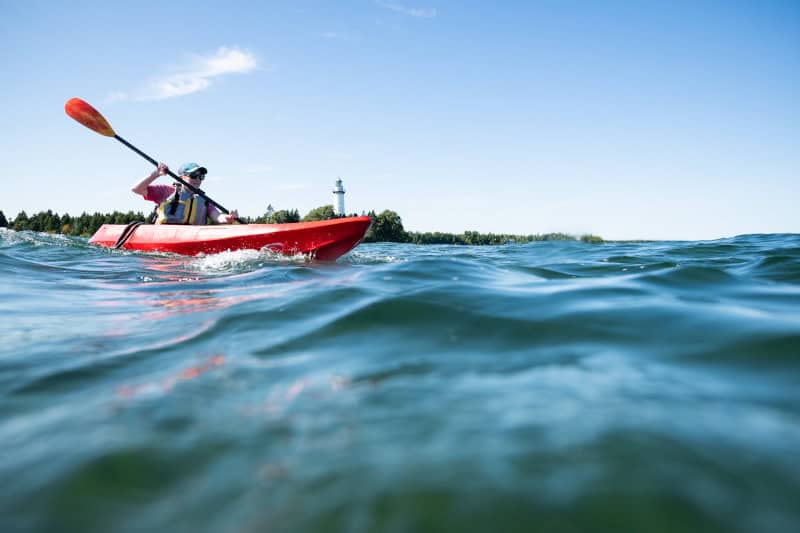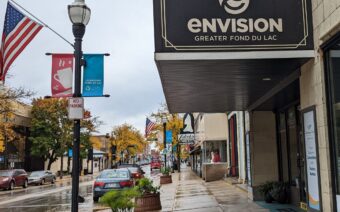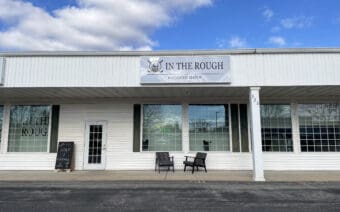
August 11, 2025
DOOR COUNTY – Whether it’s kayaking around Cana Island, picking cherries at a favorite orchard, taking a hike in Peninsula State Park or sitting on a Lake Michigan beach, Door County has long been a destination for statewide visitors or travelers from across the country.
Now, with its recent designation in Destination Forward – an industry publication produced by the George Washington University International Institute of Tourism Studies in collaboration with the Coraggio Group – Julie Gilbert, president/CEO of Destination Door County, said Door County is even more on the map.
“I don’t think it can get more community-centric than Door County,” she said. “From my perspective, what makes Door County so special are the people who live here and the people who came before. They all had a vision on how to protect what we have. They knew what the county needed to do to ensure that everybody who came after them would be able to enjoy and get inspired by what makes Door County so special.”
Though growth is important, Gilbert said that’s not all Destination Door County is focused on.
“We’re focused on making sure the benefits of tourism are felt across all our 19 communities, while preserving the natural beauty and unique character that define Door County,” she said. “It’s about investing in what makes this community thrive.”
More on the study
Gilbert said Destination Forward presents the main findings of the largest national study of its kind – examining how 35 local U.S. destination stewardship and management plans align with key sustainability themes and influence tourism policy and practice.
“The plans focus on sustainable tourism and community well-being,” she said. “It highlights how destination organizations are moving beyond traditional marketing to embrace long-term sustainability and inclusivity in tourism planning.”

Gilbert said she was “obviously” thrilled when Destination Forward reached out to Destination Door County.
“Anytime you get recognition from a major university and highlight what the organization is doing, it’s truly incredible,” she said. “It’s a tribute to our community leaders who were so committed and involved with a solid, positive plan. We were addressing the challenges we have in a way that we were able to and can accomplish things incrementally.”
More specifically, Gilbert said the nationwide stewardship plans dove into the reasons why people like to visit those communities, as well as challenges many destination organizations were experiencing.
“As they were looking at those shifts, the study identified Destination Door County as one of 35 organizations throughout the country that had taken the time to pull the community together and identify a stewardship plan that was short-term, mid-term and long-term,” she said. “[Our stewardship plan] identified all these various challenges as a community and created a plan that would identify those initiatives – then we also have an implementation plan that addresses each of those initiatives.”
Gilbert said of the 35 destinations featured, 12 are considered mountain areas, six are coastal, six are island, eight are urban and three are rural.
Door County, she said, is considered a coastal region.
“Other areas that received recognition included the Outer Banks, [North Carolina], Lake Placid, [New York], several ski resort areas in Colorado, several more locations in California and four in Hawaii – among others,” Gilbert said.
More on Destination Door County’s plan
According to Destination Door County’s website (doorcounty.com), the stewardship plan comes at a critical time for Door County, because tourism is booming, but the community is experiencing challenges related to environmental fragility, workforce infrastructure, housing inventory, child care and transportation.
“Because we had taken 18 months to put together our stewardship plan, really realigning what our core focus had been related to tourism promotion, we identified some things we were missing,” Gilbert said. “We wanted to make sure our community’s well-being was at the center of our tourism future.”
Initially, Gilbert said Destination Door County pulled together leadership throughout the county.
“This isn’t just Destination Door County’s plan – it’s really all of Door County’s plan,” she said. “Destination Door County leads it, supports it and now reports on the implementation of it. We hired a community engagement manager to ensure that if we’re leading or supporting an initiative, we know the status of things.”
More specifically, Gilbert said as an example, many communities in Door County struggle with workforce shortages and housing.
“Destination Door County doesn’t necessarily have those problems/needs, but we for sure support and advocate and help however we can with the agencies that specifically focus on those areas of concern,” she said. “It all ties into how we can have a balanced approach to tourism. Within that balanced approach is also identifying investment that needs to go back into the community.”
Gilbert said the stewardship plan involved municipal meetings, focus groups, one-on-one interviews and resident surveys.
“Then we had a steering committee set up where we got together with leadership throughout the county and received everybody’s feedback,” she said. “We took all the answers, suggestions, direction, etc. – that’s where the plan came from.”
Gilbert said the plan is intended to serve as a long-term roadmap to guide tourism strategy, investment and identify opportunities for community partners, business leaders and local municipalities.
“It will provide actionable steps toward achieving a common vision for Door County’s future,” she said. “It focuses on four areas: supporting environmental sustainability, improving infrastructure, championing community stewardship and developing and enhancing experiences.”
Gilbert said the plan is also about protecting what makes the county so special.

“That’s not just for visitors, but for the people who live here year-round,” she said. “It gives us a thoughtful, balanced framework to ensure tourism supports our environment, economy and community values in a way that’s sustainable for the long term.”
Gilbert said she has tried to look at what makes Door County different from other recreational destinations that may not have everything the county has, but have some of the same options.
“I think a big part of what Door County has is the arts, the culture and culinary experiences,” she said. “For example, we just launched the Door County Heritage Trail, which helps our historical museums and foundations. Visitors/residents utilize a web-based platform where, as they go to different sites that are part of our trail, they check in and get points. When they get a certain number of points, they get a packet of stickers.”
Gilbert said if participants reach the top tier, they receive a tote bag with the Door County Heritage Trail logo on it.
“We launched the heritage trail in mid-June, and as of recently, there were almost 700 opt-ins with it,” she said. “People are having fun with it because it’s so different.”
More work to be done
Though Gilbert said she thinks Door County does a great job promoting itself and giving visitors plenty of options, there is always more work to be done.
“I think we can always be better,” she said. “It’s important to know that as the visitor, visitor dollars are really what drive our ability to reinvest back into the county. We focus on markets where we can target that mindful traveler – the type of visitor we feel aligns with our community personality.”
To be successful, Gilbert said long-term strategic planning requires dedicated capacity and significant focus on implementation.
To read the full stewardship plan in more detail, visit the website.
 It’s a touchdown for Paper Valley’s Tyson Siebers
It’s a touchdown for Paper Valley’s Tyson Siebers Where food tells a story and farmers are rock stars
Where food tells a story and farmers are rock stars








